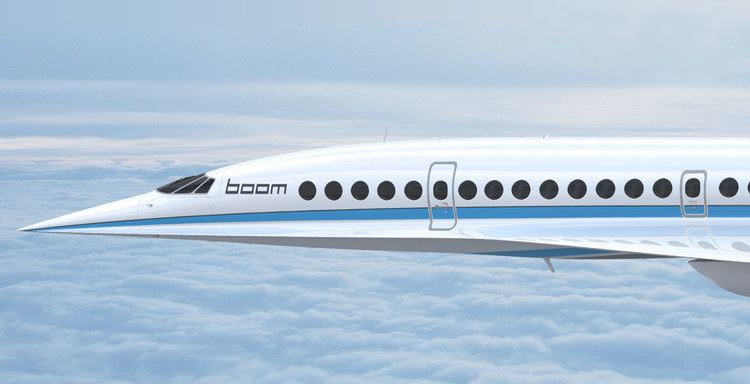Industry Aerospace Founded 2014 Parent organization National Response Corp | Website boomsupersonic.com Headquarters Denver | |
 | ||
Key people Blake Scholl (other languages), Co-founder and Chief executive
Joe Wilding (other languages), Co-founder and Chief Engineer
Josh Krall (other languages), Co-founder and CTO Products Supersonic aircraft production Profiles | ||
Boom Technology is a startup company aiming to create a 45-passenger civilian supersonic transport aircraft to fly up to Mach 2.2 (1,451 mph, 1,261 kn, 2,335 km/h). Conceptually it could fly New York City to London in 3 hours and 24 minutes at a proposed round trip cost of $5,000.
Contents
Boom technology supersonic aircraft the future is supersonic 1080p
History
The Denver-based company was founded in 2014. The company participated in a Y Combinator startup incubation program in early 2016, and has been funded by Y Combinator, Sam Altman, Seraph Group, Eight Partners, and others.
Richard Branson confirmed that Virgin Atlantic holds options for 10 aircraft; in addition, Virgin Galactic's subsidiary, The Spaceship Company, will play a role in manufacturing and testing. Boom also says they have options for an additional 15 aircraft to an unnamed European carrier; all options are valued at a combined $5 billion. The projected actual sales price of the aircraft is $200 million (without options and interior).
In March 2016, the company had concept drawings and wooden mockups of the aircraft. In October 2016, the design was stretched to around 155 ft to seat up to 50 with ten extra seats, its wingspan marginally increased, and a third engine added to enable ETOPS-free routes up to 180 min diversion time. The XB-1 one-third-scale prototype, powered by three General Electric CJ610 turbojets (a civilian J85), is anticipated to make its initial subsonic flight in late 2017, with subsequent supersonic flight testing at Edwards AFB.
Its wing configuration is a conventional compound delta for low supersonic drag, like a 75% scale Concorde: no low sonic boom as for the SAI Quiet Supersonic Transport (QSST) or laminar supersonic flow for the Aerion AS2. Due to the low wing aspect ratio (around 1.5), drag is high at low speeds and the aircraft requires high thrust at take-off. Boom wants to use moderate bypass turbofans without afterburners, unlike Concorde's Rolls-Royce Olympus. The only available are jet fighter engines, which have neither the fuel economy nor the reliability required for commercial aviation. No engine manufacturer can develop such an engine based on sales of only 10 options. Boom also needs to address the nose up attitude on landing, noise of the high jet speed engine, and the tripled fuel consumption per unit distance and per seat of a modern wide-body aircraft.
XB-1 Baby Boom
The XB-1 "Baby Boom" supersonic demonstrator was unveiled in Denver on November 15, 2016. It is 68 feet long, has a 17 ft wingspan and a 13,500 lb (6,100 kg) maximum take-off weight. Powered by three 3,500 lbf (16 kN), non-afterburning General Electric J85-21 engines with variable geometry inlets and exhaust, the prototype should be able to sustain Mach 2.2 with more than a 1,000 nmi range. Constructed of lightweight composites, it has a two-crew cockpit, chined forebody and swept trailing edges. The follow-up supersonic trijet airliner should seat 45 passengers in a normal configuration or up to 55 in a higher-density configuration, and be certificated by 2023.
